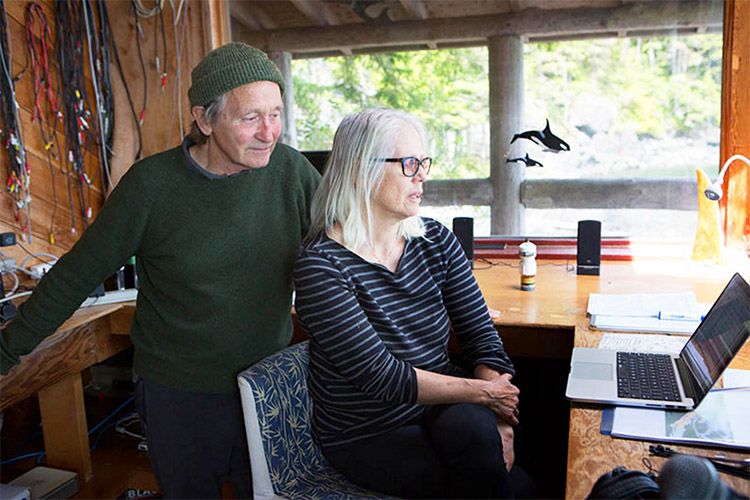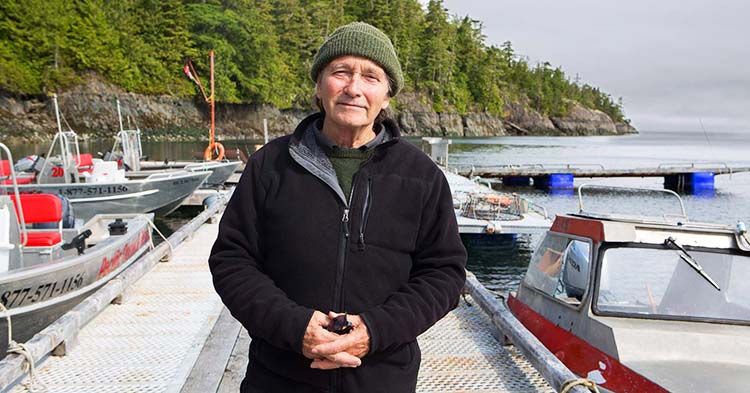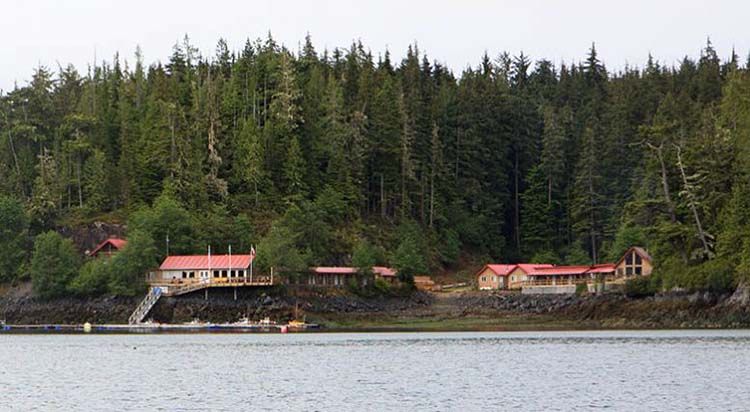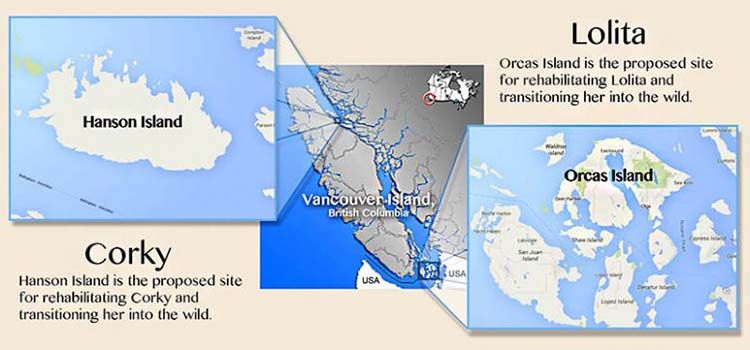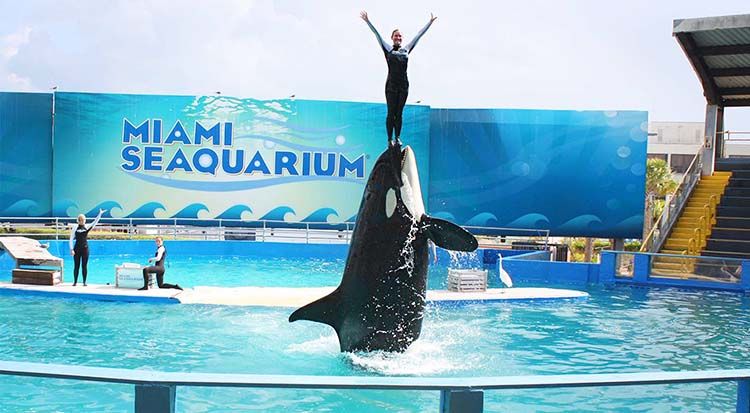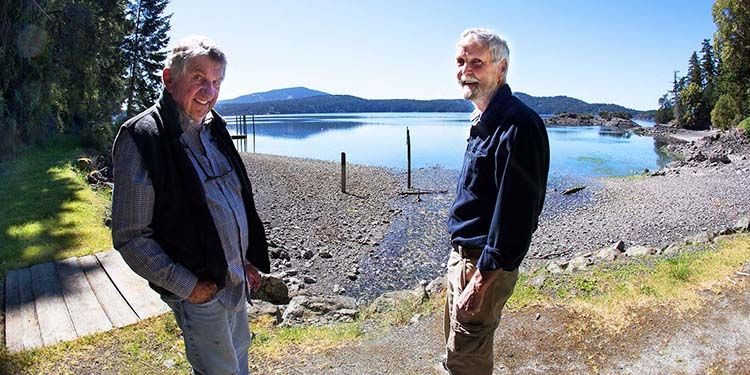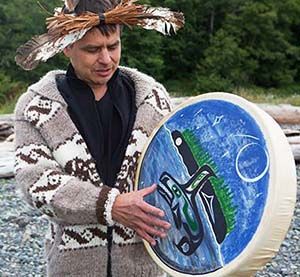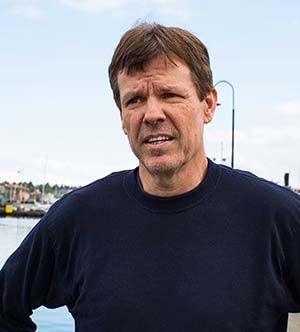
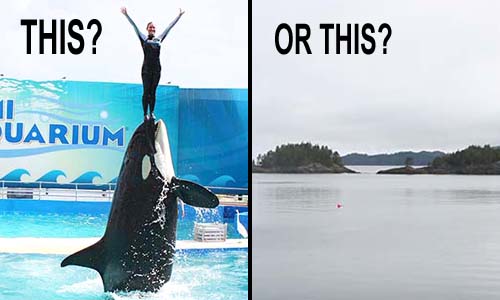
By David Kirby
Paul Spong deftly threads the June Cove through the churning tidal waters of Broughton Strait, skirting granite outcrops topped with evergreens, until we enter the bottle-green expanse of Blackfish Sound. Rounding a rocky headland on Hanson Island, we pull into a sheltered cove surrounded by thick stands of cedar, fir and spruce. In the distance, snow-flecked peaks tower above nearby Vancouver Island. Screeching bald eagles circle overhead and behind us, black-and-white Dall’s porpoises resembling miniature orcas dart around in the icy sound.
“Welcome to Double Bay,” the marine mammal scientist, who has studied captive and wild killer whales for decades, said with a smile. “This, I think, would be a terrific home for Corky.”
As I survey the serene swath of wilderness, I find it hard not to agree. Corky the killer whale is one of the star performers at faraway SeaWorld in San Diego. In 1969, at around age four, the orca was snatched from her family (which still patrols this area each summer) in a notorious roundup in Pender Harbor, on the British Columbian mainland. Six whales were removed from their pod and sold to theme parks and aquariums, hungry for more of the crowd-pleasing ticket sellers. Now, nearly 47 years later, Corky is the longest-held captive orca.
She is one of 56 killer whales confined to tanks in the U.S., Canada, Russia, China, Japan, France, Spain and Argentina. Their lives are vastly different from those of orcas in the ocean, which typically stay with their families for life; captive orcas are often removed from their mothers, sometimes at very young ages. Orcas in the wild can swim up to 100 miles per day; orcas in tanks are lucky to swim 100 laps. Most studies show that death rates for captive orcas are higher than for wild ones. Unlike their captive relatives, orcas in the ocean don’t need antibiotics, antifungals and even antidepressants to maintain their health and well-being.
Spong and his wife, Helena Symonds, who operate the nonprofit research center OrcaLab, have been hoping to return Corky to her native waters for decades. They even envision the whale rejoining her pod in the wild. But the obstacles have been daunting. SeaWorld vows it will never transfer any of its marine mammals to sanctuaries because, the company claims, it would endanger the animals.
But Spong and Symonds refuse to give up, bolstered by a burgeoning international movement that has risen up around them in recent years—one that seeks to deliver captive whales and dolphins into “retirement” from the noise-filled arenas and barren concrete tanks where they labor daily to entertain tourists. If Ringling Bros. can retire its elephants and research universities can send lab chimps to sanctuaries, many animal welfare advocates ask, why can’t the same be done for whales and dolphins?
Not too long ago, that question would largely have been brushed off as naive, if not patently absurd. But times are changing. When I published my book, Death at SeaWorld, in 2012, the ethics of holding huge whales in small tanks were not on many people’s radar. But the book and to a greater extent the documentary Blackfish, profoundly altered public opinion about captivity.
At first, SeaWorld tried to ignore the escalating clamor, betting that the outrage was just a fad. But ticket sales continued to flag, the company’s stock plummeted and corporate partners fled to safer waters. Then in March 2016, SeaWorld issued a stunning announcement: It would stop breeding captive orcas immediately and phase out theatrical orca shows by 2019.
The about-face has reenergized the anti-captivity movement and given hope that SeaWorld and other marine parks will one day agree to transfer at least some of their animals to seaside sanctuaries. But where will they go? In the works are at least nine “retirement” plans, under which captive whales, dolphins and porpoises would be transferred to netted-off pens in the ocean off the coasts of the U.S., Canada, Europe and South Pacific islands. The movement might extend to China, where nine Russian-caught killer whales were recently exported to Chimelong Ocean Kingdom amid a marine park building boom, though they have yet to be put on display.
“People are now seeing that these sentient beings aren’t corporate assets,” said Courtney Vail, campaigns manager for the U.K.-based Whale and Dolphin Conservation and a leading advocate of the sanctuary movement.
A More Natural Life
The marine park industry argues that transferring marine mammals to sea pens exchanges one form of captivity for another and would harm them by exposing the animals to pollution and other hazards. Sanctuary proponents counter that life in a netted-off area of the ocean is infinitely preferable to confinement in what amounts to a glorified swimming pool.
Video: See How SeaWorld’s Killer Whales Can Go Home Again
“Any sanctuary is going to be better than captivity,” said Lori Marino, a marine mammal neuroscientist, the founder of the Utah-based Kimmela Center for Animal Advocacy and the executive director of the Whale Sanctuary Project. Unveiled in May, the project has brought together marine scientists, conservationists, legal experts, veterinarians, former animal trainers and others to build the world’s first permanent seaside sanctuary for whales and dolphins held in captivity.
“We have to look at the kind of environment that their brain evolved in, what their brain evolved to do and how far or close their setting is to that natural environment,” Marino told me. “They have a brain that obtains pleasure in figuring out how to go places, how to get prey with others, in swimming and deep diving, even in navigating their social lives and communicating over long distances.”
Sanctuary advocates envision that sea pens could be established in a cove or a bay, with an anchored net closing off the mouth or perhaps among a group of small islands surrounded by barriers. In most cases, whales and dolphins would have access to acres of deep, natural seawater rather than barren concrete tanks. If possible, they would learn to catch fish rather than consuming only frozen-and-thawed food. They would receive round-the-clock monitoring and regular veterinary care but could spend their lives without having to perform tricks. Though most sites would provide public access to the animals, visitors most likely would be kept at a discreet distance. There would be no stadium-style seating filled with flashing cameras, roaring crowds and deafening music.
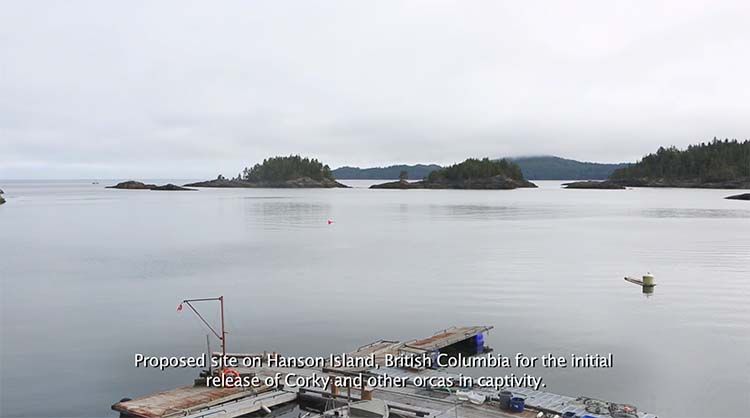
Sea pens, proponents say, could improve the overall health, well-being and longevity of the animals. How do they know this? Because pens exist, at least for certain species.
The U.S. Navy keeps 82 bottlenose dolphins—and a number of sea lions—in sea pens in San Diego Bay and at Naval Base Kitsap in Washington state, where they are trained to detect mines and “enemy swimmers” and retrieve objects from the deep. Some marine mammal facilities with swim-with-the-dolphin programs also maintain their animals in seawater, according to Naomi Rose, marine mammal scientist at the Animal Welfare Institute.
Back to Nature?
Retiring captive animals to a seaside sanctuary for the rest of their lives—while complicated and expensive—is one thing. Rehabilitating them for return to the sea is quite another.
Although many people would like to see that happen, captive-born whales and dolphins are poor candidates for such release. Not only do they have no experience in the wild, but they have no families with which to reunite. They might learn to catch food, but without a social group to join they could become solitary social misfits. Though it’s possible to release captive-bred animals, it would not necessarily be ethical or sound.
“I seriously doubt we could teach them how to be normal in a social setting,” Rose said, even though solitary whales and dolphins have been documented in the wild. “The arrogance of thinking we can teach a captive-bred whale or dolphin how to be a wild, competent adult is pretty outrageous.”
Animals obtained from the ocean are better candidates for release. Hundreds of dolphins and several pilot whales and false killer whales (members of the dolphin family) held in tanks around the world were taken from places such as Russia, Korea, the Solomon Islands, Cuba and Taiji, Japan. There are also scores of wild-caught beluga whales, mostly from Russian waters.
Of the 56 orcas in captivity, only a small number were taken from the ocean; the rest were bred in captivity. But knowing where the animals were captured is not the same as knowing where their families are.
Among all wild-caught killer whales, we know the definitive identities of the families of just two, both from the Pacific Northwest: Corky, from the A5 pod of Northern Resident whales and Lolita, a solitary orca who has been held for 46 years in a tiny pool at Miami Seaquarium, who belongs to the L pod of Southern Residents. So if the idea of repatriating animals to the ocean is to reunite them with their native pods, the notion of release for most of them is problematic.
Can Corky Swim Free?
As Paul Spong ferries me around Blackfish Sound, the 77-year-old scientist with longish, wispy hair and a playful smile concedes that his vision for the “Free Corky Campaign” has evolved over time. Spong and others have been trying to return the orca to her pod since 1990. For years, reunification seemed like an optimal and plausible option. After all, researchers are familiar with her relatives, who routinely swim by Hanson Island, home to the twin inlets of Double Bay.
No orcas are around on this sparkling spring day, but I have seen many wild killer whales. The encounters are exhilarating. They chase prey together, chattering wildly to coordinate the hunt. They “spy hop” above the surface to get a look around and leap from the sea in exuberant, thunderous breaches. I once watched an entire pod of orcas frolicking in a cove, only to disappear within seconds after one of them, presumably the oldest female, gave the signal that it was time to go. Their communication skills are that staggering.
Two members of Corky’s immediate family are still alive—siblings that were born after her capture but share the same calls. Spong thinks other relatives would also recognize her as one of their own.
Video: Watch and listen to Corky’s family, from the A5 pod of Northern Resident whales, seen on Aug. 13, 2015. (Video: Megan Hockin-Bennett for Orcalab)
“These are extremely intelligent animals with long memories,” he told me, adding that each family group has a distinct set of vocalizations or dialects. “We can identify approaching orcas just by the sounds they make, even before we see them.”
“When we began this decades ago, our idea was that she’d learn how to catch live fish again and we would see how she was interacting with her family group,” Spong said, gazing at Corky’s potential future home. “And then at a point where it was obvious she was interacting with them, we would let her go with a tracking device.”
Sadness engulfs Spong’s face as he continues. “The problem now is that so much time has passed—she’s so much older—that we’re hesitant to go there,” he said. “Our thought at this point is to create a permanent retirement home for her and care for her.”
When I ask SeaWorld about this, company officials email me a written statement. “Putting our killer whales in sea cages would expose them to disease, pollution and other man-made and natural disasters,” the statement reads. “In addition, given the ages of our whales, the length of time they’ve spent in human care and the social relationships they’ve formed with other whales, it would do them more harm than good [and] could cause the whales immense stress and even death during transport and release.”
Still, Spong clings to hope for a corporate change of heart. “We think it would be a great thing for SeaWorld,” he said. “They’re recognizing that when they do good things, the public responds.” SeaWorld would need to be directly involved with Corky’s retirement. “She would need trainers she was familiar with.”
Spong steers past the outcrops along Double Bay’s mouth, explaining how barriers could connect them to complete Corky’s enclosure. We enter the tranquil inlet. Spong points to a compound of low-rise wooden buildings along the shore, originally built as a private fishing lodge. He said that he intends to look into buying the place. With its dock, restaurant and sleeping quarters, it’s ready-made for housing workers and even visitors who would pay to see Corky, helping to offset some of the costs.
Those costs are considerable. While the lodge would negate the need for building infrastructure, buying the place and all the land around Double Bay would likely run into the millions. Even the nets could cost $100,000 or more.
Two Homes for Lolita
Of all the orcas in captivity, perhaps none engenders as much public sympathy as Lolita, who has spent the past 46 years at Miami Seaquarium, much of it alone, with the exception of a few dolphins. Her enclosure is small: 80 feet long and 35 feet wide, with a depth of just 20 feet, the same length as her body. She has limited protection from the blistering Florida sun.
Lolita was taken from her family at about age four in 1970 during the largest orca roundup in history, at Penn Cove on Whidbey Island, about 40 miles northwest of Seattle. More than 90 whales, probably the entire Southern Resident population, were corralled into the narrow bay. Four of them died and seven of the youngest ones were sold to marine parks. Today Lolita is the only Southern Resident of the 45 captured who is still alive in captivity.
Lolita might also stand the best chance of any captive orca of being delivered from her confines. The Southern Resident orca population was listed as endangered in 2005 and in 2013 the federal government agreed to include Lolita in the listing in response to a lawsuit from animal welfare groups. Although a federal judge on June 2 rejected conservationists’ claims that Lolita’s cramped confines at Miami Seaquarium violate the U.S. Endangered Species Act, the animal rights activists are appealing the ruling and there is another pending action against the federal government that could conceivably result in Lolita’s release.
There are two competing plans for retiring the whale to her native waters.
The older plan, dating to 1995, was conceived by Ken Balcomb, director of the Washington state–based Center for Whale Research, along with his half-brother Howard Garrett, an outspoken anti-captivity activist featured in Blackfish and his wife, Susan Berta. Together they run the Orca Network conservation organization on Whidbey Island, not far from Penn Cove.
On a sunny May morning, the snow-covered Olympic Mountains glistening across the Strait of Juan de Fuca, Garrett and I make our way to horseshoe-shaped Orcas Island, in the San Juan Islands, to tour the site he has selected for Lolita—265 acres of wooded waterfront property owned by Jim Youngren, a real estate developer who would donate the land for the killer whale’s resettlement.
We head down to the estate’s waterfront, which includes a large cove that would be netted off for Lolita. Garrett and Youngren say the site is ideal: It is isolated, protected from the elements and there is little boat traffic on the sound. And, they say, it would be temporary. After her arrival, they would embark on a regime of training Lolita to reunite with her family by improving her stamina, teaching her to catch fish and taking her out on “walks,” accompanied by a boat, into the sound.
The detailed proposal for Lolita’s rehabilitation focuses on weaning her from dependence on humans for survival and includes plans for a project manager, a staff veterinarian, caregivers, divers, security personnel and a water quality manager. The total estimated budget, for transportation, infrastructure and feeding and caring for Lolita for three to six months ranges from $758,000 to about $1.56 million.
“We will raise the money through traditional fund-raising, including individual small donors, major foundation grants and appealing to benevolent benefactors, anybody willing to pitch in to help Lolita go home,” Garret said. “Unfortunately, I don’t have a Rolodex of billionaires that I play golf with.”
Money isn’t the only obstacle. Miami Seaquarium has consistently rejected the idea of retiring the whale.
“There is no scientific evidence that … Lolita could survive if she were to be moved from her home at Miami Seaquarium to a sea pen or to the open waters of the Pacific Northwest,” Andrew Hertz, Miami Seaquarium’s general manager, informed me in an email. “It would be reckless and cruel to jeopardize Lolita’s health and safety. Miami Seaquarium is not willing to experiment with her life in order to appease a fringe group.”
But Garrett is confident that Lolita will recognize her family and yearn for reunification with them. (Lolita’s mother is alive and well). He envisions the day that Lolita hears her family in the ocean.
“It would be the moment we’re all waiting for,” he said. “Her family might be 20 miles away, chattering as normal and she recognizes them and calls back in their calls that only that family uses. If they’re curious, they’ll probably make a beeline to her. I don’t think it’s going to be an immediate warm welcome. I think there will be a time of rebuilding relationships and trust levels. But that will be the most fascinating scientific experiment: How tight are those bonds and how clear is that memory after all those years?”
After visiting Orcas Island I take a ferry to Port Angeles and make the 90-minute drive along a narrow, winding highway that skirts the Strait of Juan de Fuca to the far northwestern corner of the continental U.S., home to the 47,000-square-mile Makah Indian Reservation. Just before Cape Flattery, I pull into Neah Bay, a large, curving expanse bisected by a mile-long rocky jetty connecting the mainland to Waadah Island.
It is here, alongside the jetty, that an informal coalition of conservationists and members of the Makah Tribe want to install a floating pen, with nets anchored to the seafloor, to house Lolita.
I meet with two key members of the project: Michael Harris, a Seattle-based network television journalist and former president of the Orca Conservancy and Micah McCarty, former chairman of the Makah Tribal Council and member of the federal government’s National Ocean Council.
There is an orca on McCarty’s family crest. Like most Native American tribes in the region, the Makah revere killer whales in their mythology, in which orcas are considered “Killer Whale People” who live in villages under the sea and put on orca costumes when they come to the surface.
In 2008, Harris was contacted by a number of Hollywood luminaries, including Ron Howard and his producing partner Brian Grazer, who had heard about Lolita’s plight and wanted someone to devise a plan to return her to the Pacific Northwest.
Their plan recommends a project team of five people to direct day-to-day operations, a 10-member scientific advisory team, a chief veterinarian, a “boat follow” team, a bay pen team and a project security chief. Before leaving Florida, Lolita would be thoroughly examined for infectious diseases or any medical condition that would put her in danger during transport to the sea pen.
Once in her pen, Lolita would be taught to catch fish and be conditioned to go out for walks, initially led by the boat team and later with a “non-human device” such as an underwater drone so she no longer associated boats with human care.
“We need to get these animals away from imprinting on people in boats,” Harris said. “You cannot ocean walk a human-imprinted whale into a congested recreational boating area. We’re 70 miles from the nearest major population center.”
McCarty says the location is ideal. There would be several levels of security, including Makah authorities and year-round access to wild salmon and other fish. Another advantage: Killer whales pass nearby 12 months of the year, he said. The proposal calls for installing underwater hydrophones on an island at the mouth of the strait, operated 24 hours a day, that could detect the approach of Lolita’s family when it came time to reintroduce her to her pod. Before swimming free, Lolita would be outfitted with tracking devices, possibly attached with suction cups, to monitor her success and rescue her if she got into trouble.
If the successful release of Lolita cannot be achieved, the plan calls for her permanent residence in the bay. “I’m an optimist, but I think the options have to be that she’ll be cared for well the rest of her life if she can’t make it in the wild,” McCarty said, noting that the pen, envisioned at 10,000 square feet, could be expanded or a new pen could be installed in a cove on Waadah Island.
Harris declined to offer a long-term budget, but looking at expenses from other orca relocation efforts, he estimated that the move from Miami and the first six months of operations would run about $1 million. The proposal calls for academic partnerships, in which universities and research centers would pay fees in exchange for access to Lolita for scientific studies.
Keiko’s Legacy
There is a rich history of wild-caught cetaceans returning to nature, with varying degrees of success. One of the earliest involved a 20-year-old pilot whale named Bimbo, who was reintroduced into the ocean in 1967 by Marineland of the Pacific, near Los Angeles, after nearly eight years in captivity. Two years after his reintroduction, Bimbo was sighted near Santa Barbara and five years later, he was seen again near San Clemente.
Without question, the most famous, expensive and controversial orca release involved Keiko, star of the 1993 Warner Bros. movie Free Willy, who was yanked from his family near Iceland in 1979 when he was about two years old. Keiko had languished for years at a Mexico City amusement park in a small, shallow pool filled with tepid tap water spiked with chlorine and table salt. The subpar conditions caused Keiko to lose weight and contract a papilloma viral infection that left large patches of his skin with disfiguring warts.
Keiko’s plight gained worldwide attention. In 1995, the California-based Earth Island Institute, with seed money from Warner Bros. and American telecommunications billionaire Craig McCaw, helped establish the Free Willy-Keiko Foundation. A $7.3 million, high-tech rehab facility was built at the Oregon Coast Aquarium with the intention of returning Keiko to the ocean. In early 1996, Keiko was flown to his new tank, which was filled with cold, fresh seawater. He learned to catch fish to supplement his frozen diet.
In September 1998, Keiko was transferred to a floating sea pen in Iceland anchored in a spectacular inlet surrounded by volcanic cliffs. Over the next few years, Keiko’s health and stamina continued to improve. In 2000 Keiko began taking walks in the open ocean, outfitted with a tracking device. He often stayed away for days. Then, in the summer of 2002, for unknown reasons, Keiko took off, embarking on a 50-day, 1,000-mile odyssey across the North Atlantic, under constant satellite tracking, to the coast of Norway. Data from his tag showed that Keiko made repeated deep dives on his journey, suggesting he was foraging for fish.
The killer whale’s arrival in Norway sparked a public sensation, as hordes of boaters and swimmers flocked around the Hollywood star. It was a terrible situation, given that the idea was to wean him from humans. Critics declared the experiment a wretched failure. Keiko’s caretakers relocated to Norway and walked him further up the coast to Taknes Bay, far from the raucous crowds. He spent the next 15 months coming and going as he pleased. Then, in December 2003, he began exhibiting signs of lethargy and lack of appetite. On Dec. 12, Keiko beached himself on the rocky shoreline and he died that evening. No necropsy was performed, but his vet suspected the cause was pneumonia.
Skeptics accused the project of murdering a hapless animal that never should have been released. The seven-year project, they noted, had come with a $20 million price tag, said David Phillips, executive director of the Earth Island Institute, which worked on the release project. “Keiko had five years with the sights and sounds of natural seawater,” he said. “I think it was a great success in terms of Keiko, his well-being and the whole world that wanted to do the right thing.”
What’s Next?
Are seaside sanctuaries a pipe dream of well-meaning but misguided whale huggers? Critics say the money spent on sea-pen retirement could be better used on conservation of wild animals. “I find that the continued debate over SeaWorld’s 27 well-cared-for killer whales seems to encapsulate how nonprofits in the U.S. are fighting for animals not in need of saving while ignoring species and animals that are in the wild and truly need help,” said Eric Davis, editor of the pro-industry website Awesome Ocean, which has received funding from SeaWorld.
On Tuesday, the National Aquarium in Baltimore announced that it would build the first North American seaside sanctuary by the end of 2020 for its eight Atlantic bottlenose dolphins currently living in an amphitheater at the facility.
For the past five years, aquarium officials have been evaluating the feasibility of building a seaside sanctuary and searching for possible sites, which include locations in the Florida Keys and the Caribbean.
The move will undoubtedly send tremors throughout the captive whale and dolphin industry and put pressure on companies like SeaWorld to soften their resistance to retiring some their animals to sea pens.
There are at least five other proposed whale and dolphin release projects that have a shot at coming to fruition.
Chief among them is the Whale Sanctuary Project. Leading the charge are board members Lori Marino, Naomi Rose, David Phillips and Charles Vinick, who directed the Keiko project from 1998 through 2002.
The new group’s goal is to establish a “model” sanctuary somewhere in North America where whales, dolphins and porpoises can be rehabilitated for release into the ocean or, for the majority of animals, allowed to live out their lives in an environment as close as possible to their natural habitat, one that enhances well-being and autonomy.
“We’re really focused on British Columbia right now,” said Michael Parks, a licensed engineer and commercial freighter captain who worked on the Keiko project for five years. “There are so many good-looking sites there, especially the west side of Vancouver Island, with waterways that go quite a ways inland, provide good protection and have access to road systems.” Parks is also looking at sites in southeast Alaska, Washington, Maine and Nova Scotia.
The ideal site must not only be protected and accessible year-round but has to have the right temperature, salinity and seafloor depths; tidal action to flush out animal waste; an area for veterinary care and animal husbandry; and room onshore to construct a command post and visitor center. The group plans to allow public access, which is legally required for U.S. sites, not only to educate people about marine mammals but also to accept donations. The site will likely have two sections: one for rescued cetaceans and wild-caught captives being rehabilitated for release and the other to permanently house those that cannot be freed. Federal, state and local authorities will have to sign off.
Project officials are expecting to spend upwards of $20 million raised from donors to acquire a site, install nets and build infrastructure. They’re off to a decent start. Munchkin, a global baby-product company, has donated $200,000 for the site search and pledged at least another $1 million to the project. Munchkin CEO Steven Dunn tells me the idea came to him after a claustrophobic experience in an MRI machine.
“I thought, This is what captive orcas feel like,” he said. “I had empathy for them that I couldn’t get out of my head.”
What if they built a sanctuary and nobody came? Marino says that rescued marine mammals might be among the first arrivals. She, like many others in the movement, believes that parks and aquariums might one day bend under public pressure and retire parts of their “collections.”
Other sea-pen projects are on the drawing board. Merlin Entertainments Group and its aquarium division, Sea Life, which is opposed to keeping marine mammals in tanks, announced in 2009 that the company was working with Whale and Dolphin Conservation to create a sanctuary plan for belugas and dolphins at properties it had acquired.
“We’re working towards advancing two sanctuary projects right now,” said Whale and Dolphin Conservation’s Courtney Vail. “One involves relocating three female belugas caught in Russia that are now at Changfeng Ocean World in Shanghai, a Merlin-acquired property. Merlin is working toward readying them for relocation to an arctic sanctuary that WDC [Whale and Dolphin Conservation] is helping to site and develop.”
Vail’s group is also working on a feasibility study to develop a bottlenose sanctuary in the Mediterranean within five years.
One of the most well-known sanctuary efforts involves Morgan, a female orca who was found, alone, emaciated and sick, off the Netherlands in 2010. The three-year-old killer whale was captured and taken to a local theme park, which was given a permit to rehabilitate her and return her to the sea. That never happened. Despite months of legal wrangling by animal welfare advocates, in 2011 Morgan was sent to Loro Parque in the Canary Islands. She was put in a tank with five other killer whales living there on a “breeding loan” from SeaWorld, which today claims ownership of Morgan.
Almost from the beginning, Ingrid Visser, a renowned killer whale scientist and founder of New Zealand’s Orca Research Trust, has fought for Morgan’s liberation. Visser is also a leading sea-pen proponent whose recent renderings of a conceptual high-tech sanctuary—with an expansive modern pier and attached husbandry pen and glassed-in observation centers for paying visitors—were derided by industry defenders as being little different from SeaWorld.
Visser and some colleagues were able to obtain a few recordings of Morgan’s vocalizations while the whale was in Holland and they matched them with a group of Norwegian whales known as P pod, though the identity of Morgan’s immediate family remains unclear.
Visser cofounded the Free Morgan Foundation and helped devise a plan to send the killer whale to a sea pen in Norway, with the intention of reuniting the orca with her family.
“We have at least five different sites in mind and we’ve looked at three of those in detail,” she told me. “One is a [fjord] where the entrance is protected from large swells and it’s within a half-mile of known feeding grounds of Norwegian orca, but it has limited road access. Another one is within a group of islands, though it’s near a fishing harbor.”
But, Visser said, “there’s no point in building a sea pen if the authorities won’t release her. It’s putting the cart before the horse.”
If Morgan’s reunification with her family fails, the Free Morgan Foundation is prepared to look after her for life.
“Let’s at least improve her life with a fjord to swim in,” Visser said. “Or even train her to swim beside a boat and go out with whale-watching tours and use that for education and science. It’s far better than where she is now, doing the tango and moonwalk for tourists.”
The Whale Sanctuary Project’s Marino firmly believes that day is coming for Morgan and many other captive killer whales.
“The SeaWorld announcement about breeding is a good one, but they need to take the next step and transfer the animals that are going to be there for the next 30 years to a sanctuary,” she said. “They can’t be released, but their quality of life can be improved by orders of magnitude. Still, this is not just as easy as saying, ‘There’s a good inlet—let’s throw a net across and put some animals in it.’ It’s a solemn responsibility and it’s the best we can do for animals that are in captivity.”
This article was reposted with permission from our media associate TakePart.
YOU MIGHT ALSO LIKE
Nepal’s Extinct Bird Spotted After Disappearing for 178 Years
Chile’s Salmon Industry Using Record Levels of Antibiotics to Combat Bacterial Outbreak
Is it Too Soon to Consider Removing Giant Pandas From the Endangered Species List?
Newborn Sea Otter Reunited With Mom in Sweet and Rare Rescue

 233k
233k  41k
41k  Subscribe
Subscribe 

